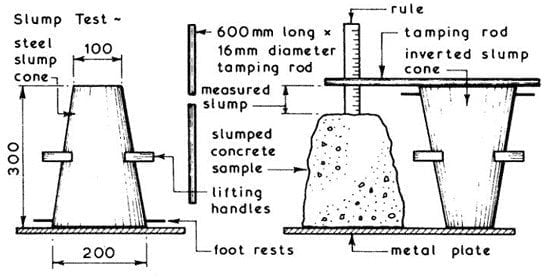The slump cone test is a standardized test used in the construction industry to measure the consistency of freshly mixed concrete. It is also known as the slump test or concrete slump test. The test measures the workability or the fluidity of concrete, which is important in determining whether the concrete mixture has the desired properties for its intended use.
To perform the slump cone test, a slump cone made of steel with a base diameter of 200mm, top diameter of 100mm, and height of 300mm is used. The cone is filled with a sample of freshly mixed concrete in three layers, and each layer is tamped with a standard tamping rod 25 times to remove any trapped air. The excess concrete is then struck off level with the top of the cone, and the cone is carefully lifted vertically and removed from the concrete. The height of the concrete after the slump cone has been removed is measured and recorded.
The difference between the original height of the cone and the height of the concrete after the cone has been removed is called the slump. The slump is measured in millimetres and is an indication of the workability of the concrete. The greater the slump, the more workable the concrete is. Different types of concrete have different slump requirements depending on their intended use.
The slump cone test is widely used in the construction industry as a simple and quick way to determine the consistency of concrete. It is important to note that the slump cone test is just one of several tests used to evaluate the properties of concrete, and should be used in conjunction with other tests to ensure that the concrete is suitable for its intended use.
Apparatus Required : The Slump Cone apparatus for conducting the slump test essentially consists of a metallic mould in the form of a frustum of a cone having the internal dimensions as : Bottom diameter : 20 cm, Top diameter : 10 cm, Height : 30 cm and the thickness of the metallic sheet for the mould should not be thinner than 1.6 mm.
The Slump Cone apparatus along with Tamper (16 mm in diameter and 600 mm length. The tamping end of rod shall be rounded to a hemispherical tip), Ruler,etc.Conforming to IS 7320:1974 Specifications for Concrete Slump Test Apparatus (Fourth revision). Reaffirmed- Dec 2013.
Procedure
- If this test is being carried out in the field, the sample mixed concrete shall be obtained. In the case of concrete containing aggregate of maximum size more than 38 mm, the concrete shall be wet-sieved through one and half inch screen to exclude aggregate particles bigger than 38 mm.
- The internal surface of the mould shall be thoroughly cleaned and freed from superfluous moisture and any set concrete before commencing the test. The mould shall be placed on a smooth, horizontal, rigid and non-absorbent surface, such as a carefully levelled metal plate, the mould being firmly held in place while it is being filled.
- The mould shall be filled in four layers, each approximately one-quarter of the height of the mould. Each layer shall be tamped with twenty-five strokes of the rounded end of the tamping rod. The strokes shall be distributed in a uniform manner over the cross-section of the mould and for the second and subsequent layers shall penetrate into the underlying layer.
- The bottom layer shall be tamped throughout its depth. After the top layer has been rodded,the concrete shall be struck off level with a trowel or the tamping rod, so that the mould is exactly filled.
- After the top layer has been rodded, strike off the surface of the concrete by means of screeding and rolling motion of the tamping rod.
- Any mortar which may have leaked out between the mould and the base plate shall be cleaned away. The mould shall be removed from the concrete immediately by raising it slowly and carefully in a vertical direction. This allows the concrete to subside and the slump shall be measured immediately by determining the difference between the height of the mould and that of the highest point of the specimen being tested.
- The above operations shall be carried out at a place free from vibration or shock, and within a period of two minutes after sampling.
Observation and data Recording
The vertical difference between top of the mould and the displaced original center of the top surface of the specimen ………… mm
| Work-ability | Compaction Factor | Slump (mm) |
| Very Low | 0.78 | 0-25 |
| Low | 0.85 | 25-50 |
| Medium | 0.92 | 50-100 |
| High | 0.95 | 100-175 |
Table 1: Relation between Work ability and Slump
The slump measured shall be recorded in terms of millimetres of subsidence of the specimen during the test. Any slump specimen which collapses or shears off laterally gives incorrect result and if this occurs the test shall be repeated with another sample. If, in the repeat test also, the specimen should shear, the slump shall be measured and the fact that the specimen sheared, shall be recorded.
